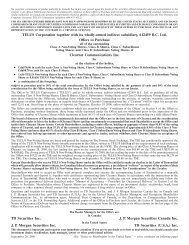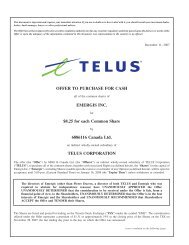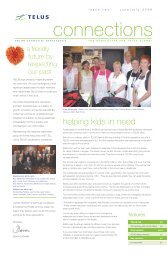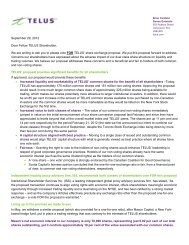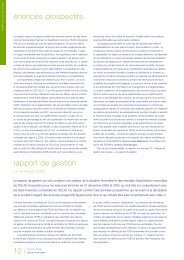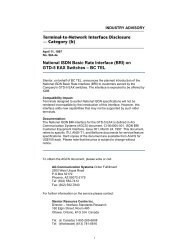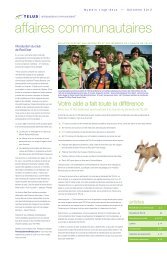Annual report - About TELUS
Annual report - About TELUS
Annual report - About TELUS
You also want an ePaper? Increase the reach of your titles
YUMPU automatically turns print PDFs into web optimized ePapers that Google loves.
(g) Income Taxes<br />
The Company and its subsidiaries follow the liability method of accounting for income taxes. Under this method, current<br />
income taxes are recognized for the estimated income taxes payable for the current year. Future income tax assets and<br />
liabilities are recognized for temporary differences between the tax and accounting bases of assets and liabilities as well<br />
as for the benefit of losses available to be carried forward to future years for tax purposes that are more likely than not<br />
to be realized.<br />
Future income taxes at December 31, 2000, consist mainly of tax reserves not available for current deduction and undepreciated<br />
capital cost in excess of net book value of capital assets arising from the difference between the Company’s<br />
depreciation rates and those prescribed for income tax purposes and losses available to be carried forward.<br />
(h) Leases<br />
Leases are classified as capital or operating depending upon the terms and conditions of the contracts.<br />
Where the Company is the lessor, the majority of capital leases are through its subsidiary, Telecom Leasing Canada<br />
(TLC) Limited, which acts as a financing intermediary. The long-term leases receivable represent the present value of<br />
future lease payments receivable due beyond one year. Finance income derived from these financing leases is recorded<br />
so as to produce a constant rate of return over the terms of the leases.<br />
Where the Company is the lessee, asset values recorded under capital leases are amortized on a straight-line basis over<br />
the term of the lease. Obligations recorded under capital leases are reduced by lease payments net of imputed interest.<br />
Revenue from operating leases of equipment is recognized when service is rendered to customers. The leased equipment<br />
is depreciated in accordance with the Company’s depreciation policy.<br />
(i) Other Long-Term Liabilities<br />
Included in Other Long-Term Liabilities are contributions from the Government of Alberta under the Individual Line<br />
Service program, which are recognized as income on a straight-line basis over the estimated useful life of the related<br />
assets. The amount to be recognized as income within one year is included with Advance Billings and Customer<br />
Deposits in the Consolidated Balance Sheet. Additional other long-term liabilities are comprised of pension and<br />
benefits obligations, building lease liability and New Media and Broadcast Fund.<br />
(j) Employee Benefit Plans<br />
The Company accrues its obligations under employee benefit plans and the related costs, net of plan assets. The Company<br />
has adopted the following policies:<br />
° The cost of pensions and other retirement benefits earned by employees is actuarially determined using the projected<br />
benefit method pro rated on service and management’s best estimate of expected plan investment performance,<br />
salary escalation and retirement ages of employees.<br />
° For the purpose of calculating the expected return on plan assets, those assets are valued at fair value.<br />
° The excess of the net actuarial gain (loss) over 10% of the greater of the benefit obligation and the fair value of<br />
the plan assets is amortized over the average remaining service period of active employees of the plan.<br />
(k) Translation of Foreign Currencies<br />
Trade transactions completed in foreign currencies are translated into Canadian dollars at the rates prevailing at the time of<br />
the transactions. Monetary assets and liabilities denominated in foreign currencies are translated into equivalent Canadian<br />
dollars at the rate of exchange in effect at the balance sheet date with any resulting gain or loss being included in the<br />
consolidated statement of income. Gains or losses arising from translation of non-current monetary liabilities are deferred<br />
and amortized over the remaining lives of the related liabilities.<br />
(l) Financial Instruments<br />
The Company’s financial instruments consist of cash and temporary investments, accounts receivable, income taxes<br />
receivable, leases receivable, bank indebtedness, accounts payable and accrued liabilities, dividends payable, short-term<br />
obligations, long-term debt and convertible debentures.<br />
> 67



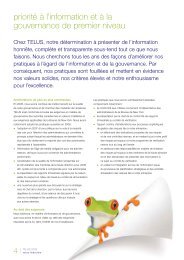
![DISK004:[98CLG6.98CLG3726]BA3726A.;28 - About TELUS](https://img.yumpu.com/16786670/1/190x245/disk00498clg698clg3726ba3726a28-about-telus.jpg?quality=85)
